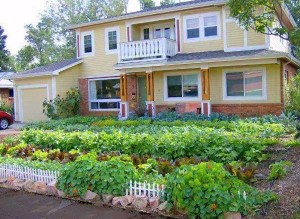Why Do We Grow Grass Seed?
For years I have been encouraging people to remove their lawns and plant food instead. As the economy continues to sour people are growing more of their own food, but for a long while I’ve been wondering about Oregon as a whole, and what we grow. After watching Food,Inc., I was again reminded about our State’s food production system, or lack thereof. The soil of the Willamette Valley is considered some of the best farming soil in the world – and in it we mostly grow grass seed and Christmas trees.
As the article “Bean Man” in the Winter 2009 issue of Edible Portland points out “Today 95% of what’s grown in the Willamette Valley is non-edible”.
Ellen Jackson writes: “As recently as 50 years ago, the assortment of fruits, vegetables, and grains produced in the valley provided the region with the means to feed itself, an important measure of social and economic stability. The once robust regional food system has floundered in favor of planting profitable non-edible crops like fescue, rye grass seed, and Christmas trees”
Beyond the questions raised by groups like Food Not Lawns about how growing grass leads to pesticide use and pollution of our waterways there’s the question of grass and allergies. During the grass cutting season many complain of a constant state of sneezing, headaches and other symptoms, and the experience seems to worsen over the years. This is great news for the makers of anti-allergy medicines, but why are we willing to grow something that people are allergic to?
Food Security. Then there’s the question of peak oil. If it’s true that we’re running out of oil, then it behooves us to start growing more of our food closer to home rather than paying to ship it from far away. In this regard, Jackson writes:
“Changing agricultural philosophies over time has meant a loss of experience and expertise in growing beans, grains, and other valuable food crops in the valley, which is two generations deep in grass seed farmers, many of whom are at least 60 years old. The Bean and Grain project recognizes that reclaiming the region’s past agricultural knowledge and reviving previous growing techniques are critical steps to breathing new life into the regional food system. Converting large parcels of grass seed acreage into plots for organic beans, grains, and edible seeds is the next order of business.”
I think we should follow the lead of the Bean and Grain project which is the work of farmer Harry MacCormack:
“The Southern Willamette Valley Bean and Grain Project is a step by step strategy to rebuild the local food system by increasing the quantity and diversity of food crops that are grown in the valley, evaluating deficiencies in the food system infrastructure, building buyer/seller relationships for locally grown food, incorporating the culture of community into the fabric of the food system, and compiling resources on organic and sustainable agricultural practices specific to this region. As the name of the project implies, central to the task is stimulating the cultivation and local marketing of organically grown beans and grains to provide a foundation for year-round food resources in the valley.”
As much as I’ve appreciated the Oregonian’s support for an end to grass-seed field burning during this legislative session, I think the real issue is growing grass-seed in the first place. I look forward to a healthy state-wide discussion of how our rich farmland is used and what makes sense long-term as we take into consideration changing fuel realities, global climate change and the need to strengthen our local food supply.
Oregon’s number 2 crop, Christmas trees, is also a crop that has a lot of problems associated with it – pesticide use (local watershed pollution), shipping trees in refrigerated trucks around the country, the carbon sequestration that is lost when the trees are harvested, erosion, the costs to municipalities to discard the trees (landfills…). This is another crop that needs a look at going forward. Considering that the planet is heating up, we might do well to pay Christmas tree farmers to just let the trees grow rather than cut them down as this article in today’s Seattle Times suggests for federal forests.





Speak Your Mind